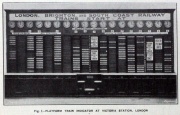Victoria Railway Station
The stations origin lies with the Great Exhibition of 1851, when the West End of London and Crystal Palace Railway came into existence, serving the site of the exhibition, which had been transferred to Sydenham from Hyde Park. The terminus of that railway was at Stewarts Lane in Battersea on the south side of the river.
In 1858, a joint enterprise, the Victoria Station and Pimlico Railway, was set up to take trains over the river, 1.25 miles in length. The railway was owned by four railway companies: the Great Western Railway (GWR); London and North Western Railway (LNWR); the London, Brighton and South Coast Railway (LBSCR); and the London, Chatham and Dover Railway (LCDR). It was incorporated by Act of Parliament in 1858.
1860 The station was built in two parts: the western side opened first, in October 1860.[1]. This was occupied by the Brighton company, with six platforms, ten tracks and a hotel (the 300-bedroom Grosvenor). The Chatham company initially had temporary facilities[2] and later (1862?) occupied a wooden-fronted building, a less imposing structure than that of the Brighton company. The Chatham company's station had nine tracks and was shared by broad-gauge trains of the GWR, which arrived from Southall via the West London Extension Railway through Chelsea. The approach tracks and station were built on the route and basin of the Grosvenor Canal.
In 1884 Fenians (predecessors of the Irish Republican Army) blew up the station cloakroom using a crude bomb made from dynamite, an alarm clock and a pistol.
The GWR remained part owner of the station until 1932, although its trains had long since ceased to use it. Each side of the station had its own entrance and a separate station master; a wall between the two sections emphasised that fact.
See Also
Sources of Information
- [1] Wikipedia



